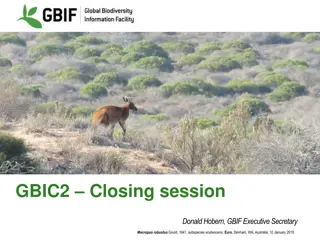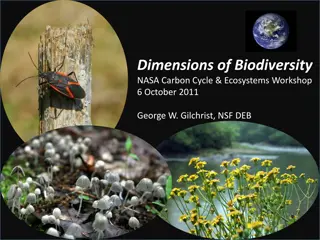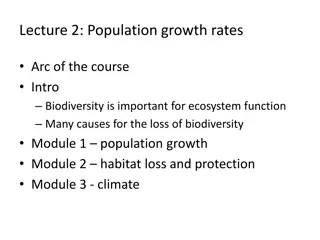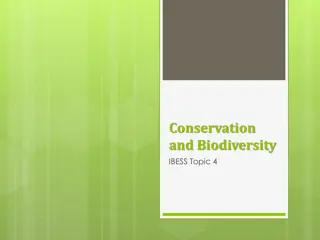Understanding Biodiversity: A Comprehensive Overview
Biodiversity, the variety of life on Earth, is a subject of fascination and importance for scientists and the general public alike. This content delves into the immense diversity of species, the levels of biodiversity (genetic, species, ecosystem), and the significance of preserving this rich tapestry of life forms. From ants to orchids, insects to bacteria, the intricate web of life on our planet holds invaluable ecological and evolutionary insights. Exploring the questions of why diversity exists, how it came about, and its critical role in sustaining ecosystems, this narrative sheds light on the wonders of biodiversity.
Download Presentation

Please find below an Image/Link to download the presentation.
The content on the website is provided AS IS for your information and personal use only. It may not be sold, licensed, or shared on other websites without obtaining consent from the author. Download presentation by click this link. If you encounter any issues during the download, it is possible that the publisher has removed the file from their server.
E N D
Presentation Transcript
Abhipedia IAS Environment & Ecology BIODIVERSITY-1 Pritam Sharma Abhimanu IAS ABHIMANU IAS : COMPLETE GENERAL STUDIES PRE CUM MAINS COURSE CALL 7347432666, MAIL AT INFO@ ABHIMANU.COM.. 1
Abhipedia IAS BIODIVERSITY- AN INTRODUCTORY If an alien from a distant galaxy were to visit our planet Earth, the first thing that would amaze and baffle him would most probably be the enormous diversity of life that he would encounter. Even for humans, the rich variety of living organisms with which they share this planet never ceases to astonish and fascinate us. The common man would find it hard to believe that there are more than 20,000 species of ants, 3,00,000 species of beetles, 28,000 species of fishes and nearly 20,000 species of orchids. Ecologists and evolutionary biologists have been trying to understand the significance of such diversity by asking important questions Why are there so many species? Did such great diversity exist throughout earth s history? How did this diversification come about? How and why is this diversity important to the biosphere? How do humans benefit from the diversity of life etc ? ABHIMANU IAS : COMPLETE GENERAL STUDIES PRE CUM MAINS COURSE CALL 7347432666, MAIL AT INFO@ ABHIMANU.COM.. 2
Abhipedia IAS WHAT IS BIODIVERSITY? As the name is itself explanatory; bio= life and diversity means multiplicity or variety. This in simplest terms translates into what we call as the variety of life that inhabit this planet or found thriving on this biosphere. In other words, biodiversity is the variety of species on Earth. The biosphere supports between 3 and 30 million species of plants, animals, fungi, single-celled prokaryotes such as bacteria, and single-celled eukaryotes such as protozoans. Of this total, only about 1.4 million species have been named so far, and fewer than 1 percent have been studied for their ecological relationships and their role in ecosystems. A little more than half the named species are insects, which dominate terrestrial and freshwater communities worldwide; the laboratories of systematists are filled with insect species yet to be named and described. ABHIMANU IAS : COMPLETE GENERAL STUDIES PRE CUM MAINS COURSE CALL 7347432666, MAIL AT INFO@ ABHIMANU.COM.. 3
Abhipedia IAS LEVELS OF BIODIVERSITY- 3 LEVELS 1. Genetic biodiversity: It refers to the total genetic information contained in the genes of all the species. It also refers to the variation in the genetic information between species as well as the variations between the individuals of the same species. For example, the human beings are quite distinct in terms of their genetic make up. 2. Species diversity: It refers to the vast variety of species living on the planet Earth. In this sense, it refers both to the number of species and number of individuals within each species. For example, there are around 1.4 to 1.7 million species that have been named and the number of individuals vary from species to species like in Insects which are so species diverse that out of every 10 animals, 7 are insects 3. ABHIMANU IAS : COMPLETE GENERAL STUDIES PRE CUM MAINS COURSE CALL 7347432666, MAIL AT INFO@ ABHIMANU.COM.. 4
Abhipedia IAS Ecosystem diversity: It refers to the variety of habitats which are not necessarily favourable to all, variety of natural communities as we find in our study of the different terrestrial and aquatic biomes and different ecological processes in the biosphere. from the above therefore, we can say that biodiversity can be studied both on a smaller scale and a larger scale. On a smaller scale, one can use biodiversity to describe the variation in the genetic makeup of an organism. Whereas, on a larger scale, one can use it to describe various types of ecosystems on the whole biosphere.
Abhipedia IAS PATTERNS OF BIODIVERSITY It is interesting to note that the patterns of biodiversity vary along the latitudinal gradients. This means that The diversity of plants and animals is not uniform throughout the world but shows a rather uneven distribution. For many group of animals or plants, there are interesting patterns in diversity, the most well-known being the latitudinal gradient in diversity. In general, species diversity decreases as we move away from the equator towards the poles. With very few exceptions, tropics (latitudinal range of 23.50 N to 23.50 S) harbour more species than temperate or polar areas. Colombia for example, located near the equator has nearly 1,400 species of birds while New York at 410N has 105 species and Greenland at 710N only 56 species. India, with much of its land area in the tropical latitudes, has more than 1,200 species of birds.
Abhipedia IAS WHY TROPICS ARE DIVERSITY RICH REGIONS? A question may be asked as to what is so special about tropics? In this regard, the Ecologists and evolutionary biologists have proposed various hypotheses; some important ones are: (a) Speciation is generally a function of time, unlike temperate regions subjected to frequent glaciation in the past, tropical latitudes have remained relatively undisturbed for millions of years and thus, had a long evolutionary time for species diversification, (b) Tropical environments, unlike temperate ones, are less seasonal, relatively more constant and predictable. Such constant environments promote niche specialization and lead to a greater species diversity. MPLETE GENERAL STUDIES PRE CUM MAINS COURSE CALL 7347432666, MAIL AT INFO@ ABHIMANU.COM.. 7
Abhipedia IAS (c) There is more solar energy available in the tropics, which contributes to higher productivity; this is turn might contribute indirectly to greater diversity. What does Earth s biodiversity inventory tell us? Robert May places the global species diversity at about 7 million considering the most conservative and scientifically sound estimate although, some extreme estimates put the biodiversity quantum on the earth between 20 to 50 million species. According to the currently available data of species inventory, More than 70 per cent of all the species recorded are animals, while plants (including algae, fungi, bryophytes, gymnosperms and angiosperms) comprise no more than 22 per cent of the total. Among animals, insects are the most species rich taxonomic group, making up more than 70 per cent of the total.
Abhipedia IAS That means, out of every 10 animals on this planet, 7 are insects. Again, how do we explain this enormous diversification of insects? The number of fungi species in the world is more than the combined total of the species of fishes, amphibians, reptiles and mammals. It should be noted that these estimates do not give any figures for prokaryotes. Biologists are not sure about how many prokaryotic species there might be. The problem is that conventional taxonomic methods are not suitable for identifying microbial species and many species are simply not culturable under laboratory conditions. If we accept biochemical or molecular criteria for delineating species for this group, then their diversity alone might run into millions. ABHIMANU IAS : COMPLETE GENERAL STUDIES PRE CUM MAINS COURSE CALL 7347432666, MAIL AT INFO@ ABHIMANU.COM.. 9
Abhipedia IAS HOW DIVERSE IS INDIA IN BIOLOGICAL DIVERSITY? Although India has only 2.4 per cent of the world s land area, its share of the global species diversity is an impressive 8.1 per cent. That is what makes our country one of the 12 mega diversity countries of the world. Nearly 45,000 species of plants and twice as many of animals have been recorded from India. Now the question arises as to how many living species are waiting out there to be discovered and named in India? If we accept May s global estimates, only 22 per cent of the total species have been recorded so far. Applying this proportion to India diversity figures, we estimate that there are probably more than 1,00,000 plant species and more than 3,00,000 animal species yet to be discovered and described unless they become extinct before we could actually discover them
Abhipedia IAS ALPHA, BETA AND GAMMA BIODIVERSITY Alpha diversity: Whittaker (1972) described three terms for measuring biodiversity over spatial scales: alpha, beta, and gamma diversity. Alpha diversity refers to the diversity within a particular area or ecosystem, and is usually expressed by the number of species (i.e., species richness) in that ecosystem. For example, if we are monitoring the effect that our farming practices have on the diversity of native birds in a particular region of the country, then we might want to compare species diversity within different ecosystems, such as an undisturbed deciduous wood, a well-established hedgerow bordering a small pasture, and a large arable field. We can walk a transect in each of these three ecosystems and count the number of species we see; this gives us the alpha diversity for each ecosystem ABHIMANU IAS : COMPLETE GENERAL STUDIES PRE CUM MAINS COURSE CALL 7347432666, MAIL AT INFO@ ABHIMANU.COM.. 11
Abhipedia IAS BETA AND GAMMA DIVERSITY Beta diversity: If we examine the change in species diversity between these ecosystems then we are measuring the beta diversity. We are counting the total number of species that are unique to each of the ecosystems being compared. For example, the beta diversity between the woodland and the hedgerow habitats is 7 (representing the 5 species found in the woodland but not the hedgerow, plus the 2 species found in the hedgerow but not the woodland). Thus, beta diversity allows us to compare diversity between ecosystems. Gamma diversity: It is a measure of the overall diversity for the different ecosystems within a region. Hunter defines gamma diversity as "geographic- scale species diversity".
Abhipedia IAS Thank You ABHIMANU IAS : COMPLETE GENERAL STUDIES PRE CUM MAINS COURSE CALL 7347432666, MAIL AT INFO@ ABHIMANU.COM.. 13























